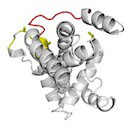The potential of microfluidics to increase the throughput and portability of analyses has been limited by the need for a tool that can probe both microscale chemistry and flow dynamics. Conventional magnetic resonance imaging (MRI) cannot sensitively record images of microfluidic flow with the required spatial and temporal resolution. By adapting remotely detected MRI - variant of conventional MRI in which the signal-encoding phase of MRI is decoupled from the signal detection process-and combining it with JPEG-style compressive sampling, Bajaj et al. are able to dramatically increase the speed of acquisition of MRI images. The spatial resolution they achieve is sufficient to capture the results of up to several thousand parallel assays on microfluidic device. Although the approach is only relevant to nuclear magnetic resonance (NMR)-active analytes or those that can be detected indirectly by contrast agents or other sensors, it may open new opportunities for a range of highly parallel analytical applications involving microfluidic chips. (Science, published online 7 October 2010; doi:10.1126/science.1192313) PH
| Attachment | Size |
|---|---|
| 175.16 KB |

